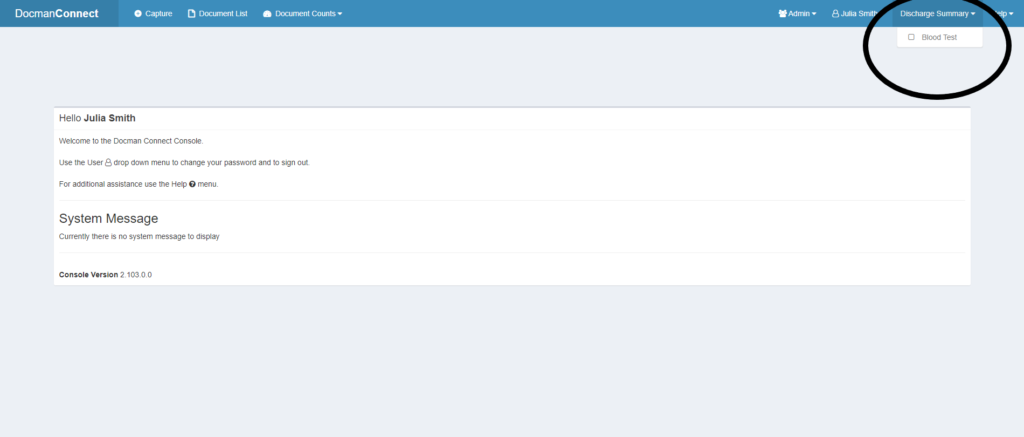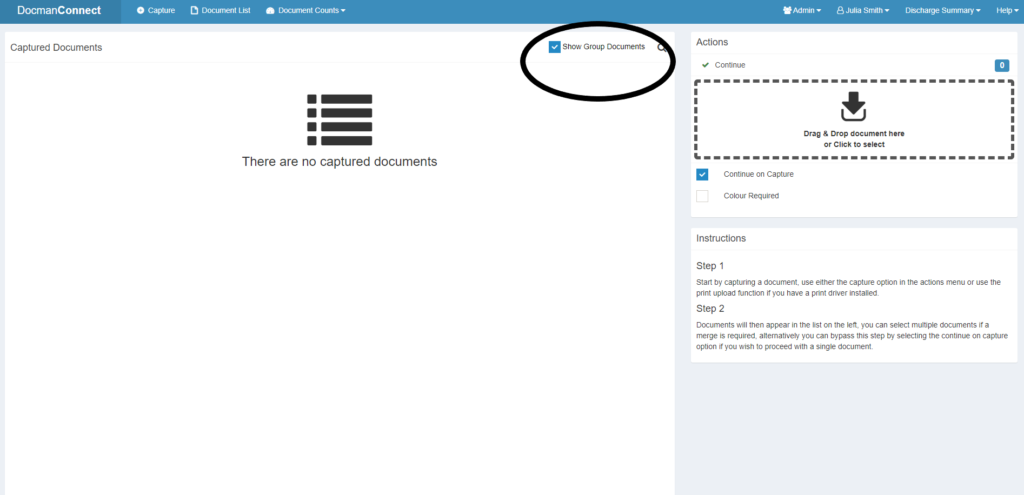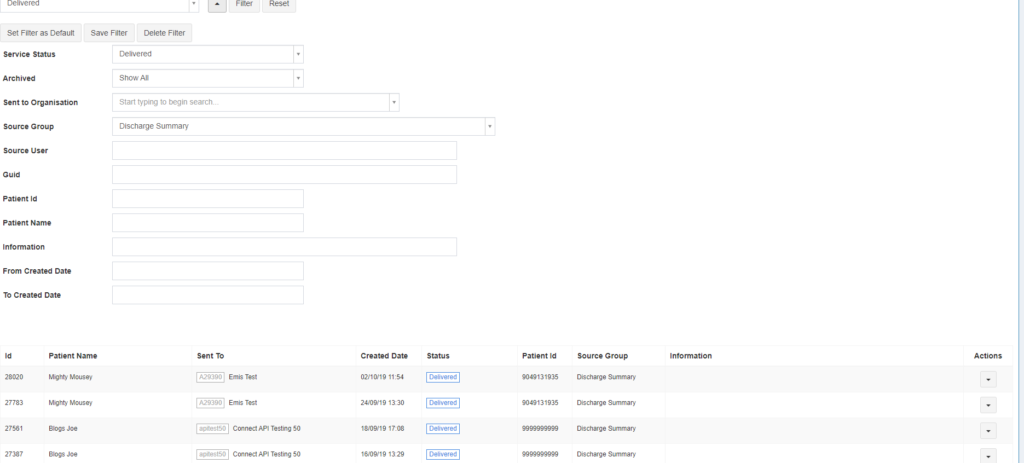GP Document Workflow
Release Notes
Docman GP 259 - October 2025
Docman GP 257 - September 2025
Docman GP 255 - August 2025
Docman GP 253 - July 2025
Docman GP 251 - June 2025
Docman GP 249 - June 2025
Docman GP 247 – May 2025
Docman GP 245 – April 2025
Docman GP 241 – March 2025
Docman GP 238 – Jan 2025
Navigation
Intro and Navigation
How to Reset Your Own Password
How to Display the Docman Desktop App Toolbar
How to Activate New Partner Product
How to Add or Remove Homepage Web Links
Patient Documents
Personalisation
Administration / Reception
Filing
NHS Mail Password Maintenance
How to Capture Documents from a Folder
Rejection Codes for Electronic Documents (EDT)
Auto-Annotate
How to Add Date and Time Stamp Annotation
How to File a Document
Create a Document Review - Workflow Template
Create a Document Review - Manual
Create a Document Review - Levels (Sequential)
How to Access and Use Document Collections
How to Manage Task Completion Settings
How to Create Folder Collections
How to Delete Corrupt Documents
Scanning
Admin Tasks
Document Maintenance
Clinical
System Admin
User Maintenance
How to Create a User
How to Edit a User Profile
How to Make a User Inactive
How to check and switch User Roles
How to Add and Remove User Roles
How to Reset a User's Password
How to Create a New User Group
How to Maintain a User Group
How to Give Users Deleted Documents Notifications
Filing Maintenance
How Should Intellisense Templates Be Used for Filing Accuracy?
Maintaining Intellisense filing templates
Best Practice for a Department Intellisense Template
Best Practice for a Hospital Intellisense Template
Best Practice for a Result Intellisense Template
How to Move a Document
Adding a Filing folder
Managing Document Folders
Managing Filing Templates
Creating and Using Custom Annotations
Understanding the NHS Mail Folders
Task Maintenance
How to Create a Workflow Template
How to create a Workflow Template (video)
How to Use Auto Start in a Workflow Template
How to Create a Task Template
How to Set the Task Priority in a Task Template
How to Create and Use a Quick Step
How to Create and Use Views
Reporting
How to Access Reports
What Predefined Reports Are Available?
How to Create a User Activity Report
How to Create an Active Task Chart
Read2 to SNOMED Switch
Docman 7 to Docman GP Migration
What are Patient Facing Services?
What are Patient Facing Services?
Patient Visibility settings when Filing - No Review
Patient Visibility settings when Filing - Review
Setting Visibility in Workflows or Tasks
Existing documents and setting visibility - Edit Filing Details
Existing documents and setting visibility - Move
Existing documents and setting visibility - Duplicate
Share
Docman Connect
Connect Release Notes
Docman Connect 259 - October 2025
Docman Connect 257 - September 2025
Docman Connect 255 - August 2025
Docman Connect 253 - July 2025
Docman Connect 251 - June 2025
Docman Connect 247 – May 2025
Docman Connect 245 - April 2025
Docman Connect 241 - March 2025
Docman Connect 238 – January 2025
Docman Connect User Guide
Connect API Codes
2 Factor Authentication
Using ‘Groups’ with Connect
Connect API Consumer Creation
Connect Password Rules
Docman Connect Retention Periods
Docman Connect Service Description
Connect Printer Drivers
Docman Connect Inbound Document Model
Referral Management System (RMS)
Docman RMS e-RS User Guide
RMS Training Material Scanning and Filing User
RMS Training Material Clinical User/Consultant
RMS Training Material Appointments/Booking Team
RMS Training Videos System Support
Step by step guide to making the desktop app visible
Configure My Apps for Reports
Forgotten your Docman password?
Technical Documents
Creating a Desktop Shortcut to Docman 10
Docman 10 API Codes
Docman 10 Accepted and Excluded File types
Docman Cloud Enabler App Deployment
Docman Desktop Application Deployment
Docman Desktop Services
Downloads Centre
Postman Configuration Tutorial
Using Docman 10 With a Proxy Server
Warranted Environment Specification (WES)
Customer Support
- All Categories
- Docman Connect
- Using ‘Groups’ with Connect
Using ‘Groups’ with Connect
Using ‘Groups’ with Connect
In Connect, there is the functionality to specify ‘Groups’ when sending documents. The concept is that you are able to separate documents by either a team, letter type, department or however you choose to use it.
In turn, you are able to sort within the Connect Console views of these groups therefore enabling you to report on the use of them.
For example, you may wish to use Groups as the different letter types you send:
- Discharge Summary
- Blood Test
- Clinic Letter
- Outpatient Letter
- Care Plan
Please visit the Connect User Guide on how to setup Groups
Once created, you are also able to assign users to one or more of the Groups. Or perhaps you are a Team Manager, you may wish to be part of all Groups, therefore you leave the Group option blank.
When you have all of your Groups created and users assigned to them, you will be able to instruct users to send their letters referencing the relevant Group.
For Capture Console users:
In the top right hand corner of your Capture screen, you will have the ability to switch Groups to the one you wish to send under:

When capturing a document, you will now send under the Group you have selected.
If you are in a Group with other members of staff, you can select ‘Show Group Documents’ to show other documents that have been captured by the same Group. This is particularly useful if more than one person sends ‘Discharge Summaries’ for example. Or if the usual member of staff who sends these documents is on annual leave, and someone else is picking up their work.

Please note whilst the Group can contain more than one individual, the ‘Contributor’ will always be unique and specify the user’s name.
Once you have sent your documents, you can then use the Document List filters to look back at the documents sent under your group, in this case, Discharge Summary:

You can also switch Groups again through this screen to reveal documents sent under other Groups:

For API users:
In order to send under the Groups you have created, you must specify the Group within the Sender Object in the JSON, for example:
“CaptureSource”: 2,
“RecipientOdsCode”: “apitest50”,
“Sender”: {
“OdsCode”: “SEN20”,
“Organisation”: “Docman Hospital”,
“Department”: “A&E”,
“Person”: “Dr Doctor”,
“Group”:”Discharge Summary”
Then you will achieve the same result when seeing the document in the Connect Console:

If you have any questions regarding Groups, please contact either the Projects Team if you are still in Deployment Phase, or the Support Desk if in Business as Usual.
Projects: dm.logistics@oneadvanced.com
Support Desk: https://customers.oneadvanced.com
Updated on August 23, 2021